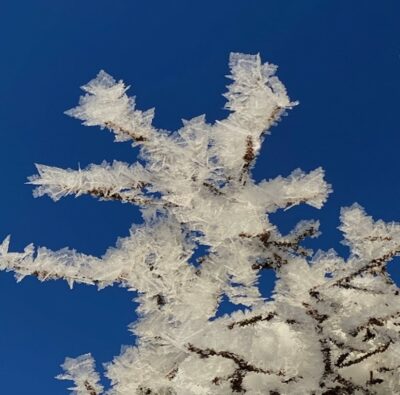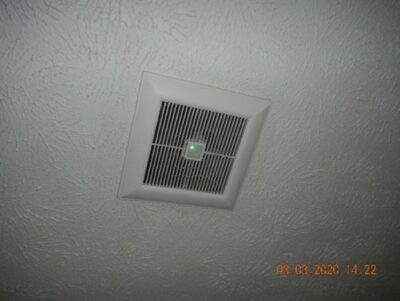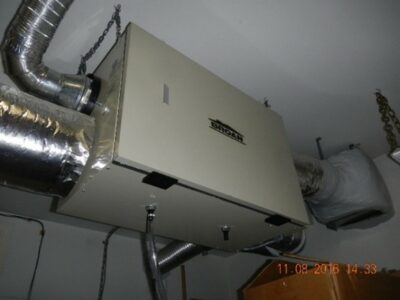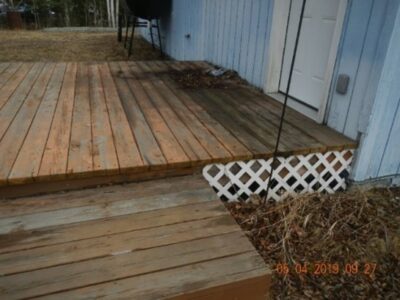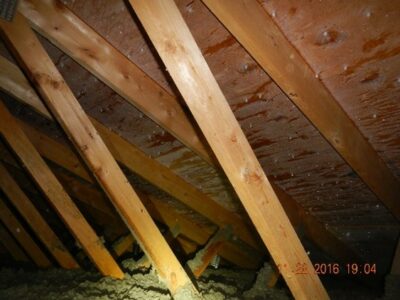
Why does moisture form in attics?
There are two main causes of attic moisture: outdoor air humidity in the fall and indoor living space air humidity throughout the fall and winter. For the sake of this conversation, we are looking at a standard flat interior living space ceiling with a sloped trussed attic roof.
First, moisture in the attic can be caused from outdoor air humidity. In the fall, lots of rain in September and October creates high humidity in the attic and it will take a few months for that humidity to equalize with the outdoor humidity. When winter temperature in the attic and outside drop quickly to the cold levels of about zero. This causes the attic air, which is humidity to condensate into frost on the cold roof or attic ceiling sheathing. Normally these cold conditions are just right between November and January. This is the same frost that forms on the outside trees and shrubs on cold, calm days.
You always see this frost on the roof sheathing and gable end vertical walls evenly distributed across the sheathing. You do not see it on the truss or on the insulation because the condensation occurs on the coldest surfaces.
This outside condensation buildup will dissipate, when the attic humidity is normalized to the outside humidity levels, as winter progresses and cold dry outside air washes out the attic over the next few months. Ventilation rates for air flow through the attic are listed in the international residential codes (r806 roof ventilation). Typically, the rate is 1 square foot of vent to every 150 square feet of attic space with about ½ of the ventilation at the eves and ½ of the ventilation through the ridge or gable end vents.
The untreated lumber in attic gets very cold in winter which stops mold growth. In addition, the roof covering on a sloped trussed attic roof system will get as high as 140 degrees fareuheight, on a day with outside temperatures of 70 degrees Fahrenheit on a sunny day. This kills active mold growth on the underside of the roof sheathing. These two temperature swings almost always kill any mold that would want to grow which would cause wood rot damage.
The second reason for frost in the attic is caused by high levels of humid indoor air escaping into the attic form the warm living space. This moisture builds up in the attic as the winter cold descends. This causes condensation and frost on the coldest area in the attic which is always the roof sheathing. Normally, high indoor humidity occurs when a humidifier, or other living conditions keep the indoor living space humidity above 35%.
When the home has too many occupants for the design of the home coupled with the living space heating temperature kept above 68 degrees Fahrenheit it will increase the actual amount of water in the air. Hot air holds more water while cold air does not. This hot moist air passes into the cold attic and condensates on the roof sheathing in the form of frost. The same thing occurs on interior windows where we see ice or wet forming at the bottom of the window glass.
Frost in the attic will also dissipate greatly when the indoor living space humidity is brought under control to about 30% relative humidity at 69 degrees Fahrenheit with the proper use of bathroom and kitchen fans.
Heat recovery ventilation (HR) systems are the very best solution for controlling indoor humidity and balanced pressures for the living space. (a home needs continuous ventilation of .01 cubic feet per minute, per square foot of living space and 10 cubic feet per minute for each occupant.).
Normally frost or moisture in the attic does not cause structural wood rot damage to the lumber or insulation and does not cause organic growth beyond what is normal for attic spaces. It will cause discoloration on the roof sheathing and top of the trusses just like raw exterior decking does when no finish is applied.
The lumber in attics get very cold in winter which stops mold growth. A roof covering on a sloped trussed attic roof system can get to 140 degrees Fahrenheit in the summer. This kills mold growth. These two temperature swings kill any mold that would want to grow and cause wood damage.
Keeping the attic as dry as possible during winter months, will provide the best performance of the attic space and roof covering. Sealing all air leaks from the conditioned interior living space into the attic keeps heat in the home and keeps living space humidity from flowing into the attic. Keeping the attic eve and roof vents open and clear of obstructions will provide the needed air flow to wash out any moisture buildup that may want to accumulate.
Never use the attic for storage. Contact a building science professional for your specific issues with your attic before performing any alterations or repairs.


